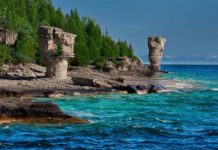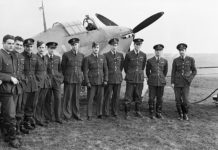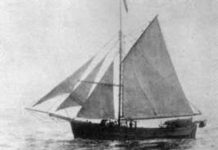The collision of the SS Imo and the SS Mont Blanc, heavily laden with wartime chemicals, set off an explosion that devastated the entire Halifax community.
One of the most devastating maritime disasters in Canadian history occurred in Halifax Harbor, Nova Scotia in 1917. A forefront of the British North Atlantic War effort, the harbor overflowed with convoys of supplies, troops and munitions preparing to cross the Atlantic into Europe. Halifax, a garrison town since its inception in 1749, juts into the west side of the harbor and at that time had a population of 50,000, including some 5,000 soldiers.
On December 5th 1917, the Halifax port sheltered more ships than usual. In addition to the 11,000 ton depot ship HMCS Niobe, which ran the operations of the Royal Canadian Navy’s examination service controlling traffic into and out of the port, numerous vessels were being assembled for convoys and other shipping was berthed at various piers along the shore, in the dry dock and in the Narrows – a channel running between Halifax and Dartmouth to the Bedford Basin.
Prelude to Disaster
The SS Mont Blanc, a 3121 ton French munitions ship captained by Aime Le Medec, arrived at the Examination Anchorage in late afternoon. Examining officer Mate Terrence Freeman boarded the ship and was surprised to find the cargo was almost exclusively explosives; 3,000 tons of picric acid, 200 tons of TNT, and 10 tons of gun cotton stored in the hold and on the deck. Drums of benzol (35 tons total) were stacked three and four high on the decks along with 300 rounds of ammunition. Mont Blanc was instructed to remain in the Anchorage until morning and Freeman reported the details of the ship and her cargo to Niobe, acknowledged by chief examining officer Frederick Wyatt.
Halifax had only recently become a gathering point of convoys and no procedure was in place for munitions ships in Traffic Regulations for the port. It’s likely there wasn’t a full sense of what was usual and what wasn’t for ships directed into the port under the fairly recent convoy scheme. Meanwhile, in the Bedford Basin the SS Imo, a Norwegian ship captained by Hakron From, awaited the coal she needed to fuel her way to New York to pick up a cargo of relief supplies for Belgium.
Mont Blanc and Imo – Collision Course
At 7:30 am on December 6th, Mont Blanc received authorization to proceed through the channel to Bedford Basin. Incoming ships were guided safely into harbor by a master mariner thus at 8:10 am, the SS Imo set off southward from the basin toward the harbor, piloted by William Hayes. Once clear of the crowded shipping in the basin, Hayes rang the engine room for more speed bringing her up to seven knots (in a five knot limit).
As a rule, in harbors or narrow channels ships pass each other port to port. However the tugboat Stella Maris had just left the harbor dry dock with two scows in tow and was heading through the channel on the Halifax side toward Bedford Basin when the Imo turned into the channel. Imo entered the channel on the Dartmouth side and both she and Mont Blanc now held to the eastern shore in sight of one another.
The Mont Blanc slowed to a crawl and signaled a short blast indicating she intended to pass Imo port side. Imo responded with two sharp blasts indicating she intended to pass Mont Blanc starboard. Mont Blanc issued the same intent a second time but Imo reaffirmed its former response.
Perilously close now, each simultaneously took emergency action. Mont Blanc signaled its intention to go hard to port and pass Imo on the Halifax side, but as the helm responded, three whistles from Imo signaled that she’d reversed her engines. While either maneuver would have averted a collision had the other stayed its course, the two actions canceled each other out. The rotary movement of Imo’s propellers produced a transverse thrust, altering the ship’s course strongly to starboard. A collision was now inevitable.To perhaps direct the blow closer to his ship’s bow, Le Medec ordered full speed astern. At 8:45 the Imo’s bow sliced into the Mont Blanc’s starboard side.
Imo withdrew from the Mont Blanc and the two ships began to drift apart. Thick black smoke pouring from the Mont Blanc told Le Medec an explosion was imminent. Aware that the pumps were crippled by the heat and heavy smoke, and efforts to quell the flames would only serve to sacrifice his crew, he issued the order to stop the engines and abandon ship. Taking two lifeboats to the Dartmouth side, they reportedly tried to signal a passing dispatch boat then disappeared into woods on the Dartmouth shore.
The Mont Blanc Explosion
As the burning ship drifted into the pier, only a handful knew of the deadly cargo. She ground to a halt close enough to the pier to ignite its wood piling. The best course of action seemed to be to get the ship away from the pier to safeguard the dock and nearby buildings. A tow was tried and failed. By this time a large crowd had gathered near the pier and many more watched from a distance.
At 9:04 the Mont Blanc exploded, vaporizing the ship and killing more than sixteen hundred people outright. 9,000 others were wounded and some 20,000 were left homeless. Aside from those close to the blast the vast majority of deaths and injuries resulted from people in the path of shattering glass or trapped in burning buildings as coal stoves and broken gas lines ignited hundreds of individual fires. The blast and shock waves flattened 326 acres, shattering windows 10 miles away, and triggered a powerful tsunami. The damage was only slightly less severe on the Dartmouth shore. Toward nightfall, the worst blizzard in over a decade contributed to loss of life. It is still considered the world’s largest man made accidental explosion prior to the nuclear age.







